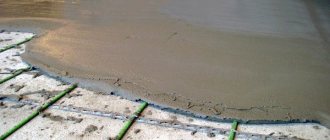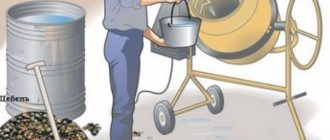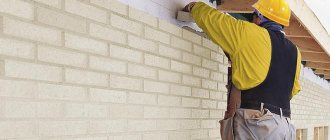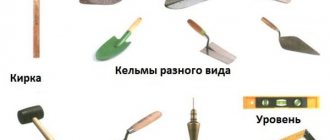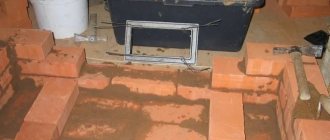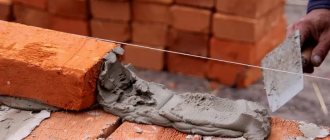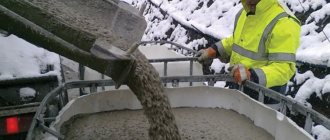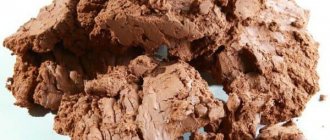Preparing mortar for brickwork in the summer is not difficult, and most of all masonry work is carried out in the warm season, completing the masonry before extreme cold. But there are situations when it is not possible to complete the entire volume of planned work on time, and masons are forced to finish the brickwork in the cold season.
In such extreme conditions, it is necessary to take into account the properties of the binders of the mortar and the freezing characteristics of the masonry mortar at temperatures below 0 degrees Celsius. The basis of the solution is water, which at sub-zero temperatures begins to freeze, which immediately turns the solution into an ice block.
To solve this problem and increase the binding properties of the masonry mortar, I add various chemical reagents to the solution, which accelerate the processes of cement hardening and increase the plasticity of the mortar.
Most often, the chemicals used are sodium nitrate, potassium carbonate and sodium chloride, but other chemical compounds are also possible. When adding chemical reagents to the solution, the air temperature should not be below 5 degrees Celsius. In addition, you cannot dilute the solution with reagents if it is already frozen or after it has recently been defrosted!
The described chemical reagents should be used only for certain types of masonry. Calcium and sodium chloride are used only for underground masonry, due to the fact that they contribute to the appearance of stains on the masonry seams.
The stains are white, which accordingly spoils the aesthetic appearance of the brickwork when these reagents are used for facing masonry. But this is not the main disadvantage of these reagents - if used excessively and disproportionately, the reagents contribute to the destruction of the brick. To obtain a high-quality mortar for bricklaying in winter, chemical reagents must be used in strict dosages!
Sometimes the process of building a building is very delayed; it continues after the arrival of cold weather.
But summer cement mixtures for construction consist of 3-4 main components, one of which is water, which becomes ice at negative temperatures. Therefore, special options for mortars for laying bricks in winter were invented. They contain additives that reduce the freezing point of water in the mixture.
Freezing method
The method is applicable for the construction of buildings up to 4 floors and a height of ≤ 15 m. The essence is to use conventional mortars to ensure their initial setting, which is ensured by heating water to 80 degrees and sand ≤ 60°C, further strengthening occurs upon the onset of thaws.
The following requirements must be strictly observed:
- at the time of installation, the temperature of the solution should be: with an average daily temperature of up to - 10° - plus 5°; to minus 20° - +10° and 15° at temperatures below -20°C. In the first 2 cases, a grade of mortar is used higher than the design one by one; in the third, the excess should be two grades;
- Bricklaying in winter is carried out throughout the entire area at the same time;
- per mile, the mortar is laid immediately on a maximum of two adjacent bricks, on a backfill ≤ 8;
- the finished solution should be applied for ≤ 30 minutes;
- the mason's mortar container must have a lid, be heated or insulated;
- a frozen solution cannot be used; heating it by adding hot water is unacceptable;
- It is prohibited to remove frozen ice crust on the walls with hot water; you can use a blowtorch or hot steam, which will additionally heat the bricks;
- after completing the daily laying, the grip is covered with heat insulators;
- Before the thaw, everything unnecessary (equipment, tools, building materials and debris) is removed from the floors.
Recommended methods for performing stone work in winter
In winter, it is recommended to lay masonry from bedded or torn rubble in greenhouses or using a solution with the addition of calcium chloride or table salt.
Walls and pillars of the above-ground part of such buildings made of bricks and blocks
can be erected by freezing with artificial thawing. For masonry done using the freezing method, cement, cement-lime or cement-clay mortars should be used.
The brand of solution should be one level higher than that used in summer conditions. The temperature of the solution used in masonry done using the freezing method is not lower than +10° at air temperatures above -10; +15 degrees - at air temperatures from -10 to -20°; +20° degrees - when the air temperature is below -20° degrees.
The grades of mortars for winter masonry done using the freezing method must be no lower than: for masonry of the correct shape:
masonry walls and foundations 10 masonry pillars 25 masonry cornices and lintels …… 50
for masonry from bedded rubble: masonry foundations and walls 25 masonry pillars 50
Wall cladding with slabs and stones at the same time as masonry done using the freezing method must be done leaving horizontal joints between the slabs that are not filled with mortar.
The calculated grades of ordinary solutions and solutions with CaCl2 or NaCl additives at the thawing stage should be taken according to Table.
Calculated grades of ordinary mortars and mortars with CaCl2 or NaCl additives for winter masonry in the thawing stage
| Brand of solution | For brick walls with thickness (in cm) | For brick pillars with smaller side size (in cm) | For walls made of lightweight concrete stones with a thickness (in cm) | For masonry from bedded rubble | |||
| 51 or more | 38 | 25 | 51 or more | 38 | 39 | 29 | 19 |
| 100 | 4 | 2 | 10 | 4 | 4 | 2 | |
| 50 | 2 | 4 | 3 | 2 | |||
| 25-10 | 2 |
For walls, the height of the floor should not exceed 12 times the thickness of the wall, and for pillars, the height of the masonry should not exceed 10 times the size of their wide face.
The maximum height indicated in the table includes the height of foundations if they are erected using the freezing method, and does not include the height of floors and foundations erected in summer conditions, as well as the height of buildings subject to long-term (natural or artificial) thawing during prolonged heating (lasting at least 15 days).
Types of additives, classification by action
Additives are produced in the form of powders and liquids, ready for use. There are concentrated solutions that are diluted before administration. The types of additives according to their effect are defined in GOST standards 24.640 - 1991 .
Main varieties:
- plasticizing agents;
- mixture setting accelerators;
- air entrainers;
- hardening retarders;
- inhibitors of corrosion processes;
- seals;
- antifreeze additives;
- decorative dyes.
There are different types of masonry, each of them requires a composition with certain qualities. Based on this, the required modifiers are selected.
Plasticizers
Used to produce winter masonry mortar for bricks, which has increased mobility . In addition, density, resistance to freezing, and water absorption increase.
- Reduce the consumption of cement binder by 10 – 15%
- Reduce water concentration by 5 – 15%
- Reduces shrinkage after setting
- Increases resistance to temperature changes
- Increases the adhesion of the mortar to the reinforcement bars
- Reduce the risk of corrosion on the stamping mesh in the masonry and metal embedded parts.
In the plasticized mixture, fewer air cavities appear that affect strength. The material does not delaminate, increasing the storage time of the mixture before laying it into a brick wall.
Accelerators
The purpose of use is indicated in the name of the additive - the substances promote rapid hardening of the mortar mixture . The additive is relevant because when the air temperature drops, the process slows down and stops in cold weather. Thawing a mixture that has not set is fraught with deterioration in quality and the appearance of cracks.
Associated action of accelerators:
- increase mobility, strength;
- increases resistance to moisture absorption by 20–25%.
The product is sold in the form of a liquid or dry powder, which is diluted with water before being added to the mixture. The dosage is written on the label, but is usually used in a concentration of 0.2 - 5.0% of the total weight . Accelerators are used not only in cold weather, but also when it is necessary to quickly build large-volume brickwork.
The additive accelerates the development of strength of the mixture, so there is no need to wait the required 28 days for this.
Accelerating modifiers contain aggressive substances, so they are not used in reinforced masonry or combined with other additives.
Anti-frost
The action is aimed at accelerating the hydration of cement at sub-zero temperatures . Chemicals allow the solution to immediately gain 30% strength, maximizing the involvement of water in this process. Then the mixture freezes without gaining 100% strength, but this amount is enough to prevent the process of delamination from starting when defrosting.
Masonry on mortar with such additives cannot be immediately loaded so that the mixture can gradually mature without the appearance of internal stress. Antifreeze additives increase the adhesion of the mass to metal bookmarks and reinforcement, because at subzero temperatures the solution does not envelop the rods and adhesion does not occur.
Reinforcing
The inclusion of fibers in the mortar mass increases its susceptibility to forces, so the strength of the brickwork increases . The solution is characterized by resistance to loads, but does not work well in bending and stretching. Because of this, cracks appear in the wall during shrinkage.
Effect of reinforcing additives:
- fills the gaps between cement grains, increases wear resistance;
- increases the service life of the structure;
- gives smoothness to the hardened mortar, eliminating microcracks.
Fiber tanks are produced on the basis of steel, basalt and polypropylene threads.
Decorative
Additives pigment the mortar mass to create a colored seam between individual wall elements. They are added to brick mortar in winter to increase the attractiveness of the structure.
Work at low temperatures
Schemes for electrical heating of masonry.
The main difficulties of construction work in winter conditions are associated with the cement composition, since it is it that is susceptible to temperature influences. In this regard, it is necessary to take into account some features of such construction:
- Antifreeze admixtures must be added to the composition, increasing the temperature of the entire solution and preventing hardening. If available, masonry can be carried out down to -50°C.
- The mobility of the composition will be within 10-13 cm along the cone.
- The plastic solution should remain this way, then it will fit well.
- After laying work, the temperature of the mixture should be periodically checked. For this purpose, you can leave small recesses in the masonry for a thermometer.
Brick laying in winter is done using the same technologies as in the warm season: the brick is laid on a cement mixture. To make winter masonry of better quality, the following methods are used:
- installation of a greenhouse;
- adding antifreeze impurities;
- electric heating;
- thermos method;
- freezing.
Due to non-compliance with the temperature regime, a crack may form.
To install the greenhouse, you will need slats and regular polyethylene in a roll. First, a slatted frame is erected around the entire construction, and then polyethylene is attached to it, creating an air space. Heating of the entire area is carried out by special devices. Under such conditions, an acceptable temperature is maintained at which the solution sets and then hardens. The heat inside the greenhouse must be maintained for several days. It is difficult to heat a large area in this way.
The addition of anti-frost impurities helps lower the freezing temperature of water, therefore allowing the solution to gain the necessary strength even in frost. Most often, mixtures of sodium and potassium chloride are added for this purpose. Mixtures of sodium nitrate and potassium carbonate can be used without subsequent heating, but the temperature of the solution must not be lower than +5°C.
Electric heating is possible for part of the masonry. To do this, electrodes powered by electricity are placed horizontally in the solution. When heated, they give off heat to the mortar and bricks. In this case, the solution hardens well, but only if all vertical joints are properly filled.
If there are no electrodes, you can use wire with a diameter of 0.3-6 mm.
The thermos method is the simplest way to ensure the solution hardens in winter conditions. In this case, the heat of the material itself is used, which is laid in parts. Each laid part is covered with thermal insulation material, which does not allow heat loss.
Freezing method
The brick is placed on a solution heated to a high temperature, which cools down after the building is erected and then freezes. This method of laying bricks ensures the strength of the wall until final freezing. In the spring, the mixture thaws and hardens. However, this process is accompanied by a fairly strong shrinkage of the entire structure, which can lead to the destruction of buildings more than 15 m high.
At what temperature can bricks be laid? When using the freezing method, it is important to adhere to several rules:
- Maintain the same temperature of the solution in all areas, otherwise the brickwork will be deformed after thawing and nothing can be done to fix the finished bed.
- This method is effective when working at temperatures not lower than -30°C.
- If the frozen solution is diluted with hot water, this will promote the formation of pores in the seams where there was previously ice.
Using the listed methods for preparing the mortar will significantly improve the reliability and strength of the masonry. Before using any of them, it is necessary to prepare in advance all the required materials and determine the expected costs.
Often beginners are concerned with the question: is it possible to lay bricks in winter? Or at what negative temperatures can bricks not be laid? In fact, the question of whether it is possible to lay bricks in the cold in winter is quite controversial and very relevant.
Many experts have diametrically opposed opinions. Some believe that work should be stopped in sub-zero temperatures.
And others are sure that winter masonry at low temperatures is the most durable. Let's figure out which of them is right, and what you will need if you still decide to build in winter.
Most often, construction work begins in early spring and ends in late autumn. Few people decide to lay masonry in the winter.
And the point here is not at all that you can’t lay bricks in winter. Nothing of the kind; in winter, just like in other seasons, you can build.
Another thing is that construction in winter requires greater costs, effort and progresses more slowly.
Masonry mortar
Masonry does not lose its strength in winter conditions if you prepare the cement mixture correctly. They are distributed by brand. In the cold season, you need to choose a solution of M50 or higher. It includes sand and cement. Next, dilute with water to the required consistency. Water cannot be added to the hardened mixture. It is important to pour not the entire mixture at once, but only the amount that will be produced per day. It should not be too liquid to avoid voids and not increase consumption. The temperature of the masonry mortar is regularly measured throughout the entire period of work. If the air t is -10, then the solution should be +5 degrees, and when the street is from -10 to -20, then the mixture is maintained at +10 degrees.
Optimal temperature for work
Temperature directly affects the strength of the solution.
To ensure the best quality of masonry, all work should be carried out in warm weather. In this case, the air temperature can fluctuate from 10°C to 25°C, and humidity - up to 75%. Such conditions allow you to create a durable and high-quality structure. The decrease in temperature is directly related to the deterioration of the hardening of the solution . Temperatures below 0°C will cause water, which is a component of the composition, to freeze. At the same time, adhesion to brick and the quality of masonry will deteriorate.
If setting occurs before the temperature drops and the solution holds the masonry, it may not harden due to freezing of the water. At sub-zero temperatures it loses the following qualities:
- elasticity;
- density of filling joints between bricks;
- strength - this characteristic does not return even with the establishment of a positive temperature and hardening of the solution.
The hardening time of the cement mixture at low temperatures increases by 4 times. If negative, the solution simply freezes. As soon as the air temperature begins to rise, the composition defrosts, but then it loses some of its basic properties. Brickwork made in winter conditions will differ in strength from summer. When planning to lay bricks in winter, it is worth considering the following construction features:
- the water in the solution is converted into ice, which leads to an increase in volume by about 10%; upon thawing it decreases;
- it is difficult to maintain the strength characteristics of the masonry;
- instability of temperatures in winter can lead to the formation of cracks throughout the structure due to voids appearing in the solution;
- Frost may form on the brick.
Features and Issues
If it is not possible to transfer stone work to warm weather in winter, the following factors should be taken into account:
- Laying bricks in frost is technologically more difficult than at above-zero temperatures.
- The duration of hardening of the cement mortar increases 3-4 times if the air temperature is 15 degrees.
- Cement mortar will not harden at zero temperature.
- Cold reduces the structure, elasticity and strength of the mixture.
- Ingress of moisture can damage the integrity of the brick.
- Gives uneven precipitation during thawing.
- At -20, masonry is not recommended, while at -30 it is strictly prohibited.
- Winter construction costs are 30% higher than summer construction costs.
In winter, you can lay bricks, but you need to monitor the quality of the cement mixture. Winter bricklaying is not complete without an additive that increases strength.
If work began in the warm season and did not end with the onset of winter, it is not advisable to postpone construction by six months. In addition, it is difficult to predict how long the subzero temperature will last. With the onset of frost, the composition of the cement-water solution changes, which significantly increases the cost of the process. An important factor is uncomfortable working conditions in winter.
Optimal temperature
As the temperature drops to below zero, the rate of hardening of the cement mortar slows down. And at low temperatures it does not harden at all due to the formation of ice in the cement mixture.
If cement mortar was used on the eve of frost and the brickwork holds, this does not mean that the mortar has hardened. It most likely lost its normal elasticity due to ice forming in it, resulting in a poor seal between the bricks. After thawing and hardening of the mortar, the strength of the brickwork decreases noticeably.
The hardening time of the solution at low positive temperatures increases 4 times. When negative, the solution sets and freezes.
But as the temperature rises, the defrosting process affects the quality and strength of the mixture. Complete restoration of the qualities of the solution after freezing can only occur with a very slow increase in temperature over the course of a week.
Its performance will be much worse compared to summer masonry, but the strength will not be restored to its original levels.
Masonry at low temperatures
Work in winter is caused by some difficulties, directly related to the temperature effect on the water in the cement mortar.
Therefore, it is necessary to take into account the following features of winter masonry:
- The formation of ice in the solution increases its volume by 10%. When defrosting, the volume returns to its original value.
- It is quite difficult to achieve the required masonry strength.
- Uneven temperature readings in winter can lead to the formation of voids in the mixture and cracks throughout the structure.
- Frost formation on bricks.
In this regard, it is necessary to adjust the composition and components of the cement mortar for low and negative temperatures as follows:
- In frosty weather, add detergent or liquid soap to the solution, while reducing the amount of water.
- The mobility of the mixture varies from 10–13 cm along the cone.
- For good masonry it is necessary to use a plastic mortar.
- After installation, periodically monitor the temperature of the solution. To do this, make a small depression in the masonry for the thermometer.
Brickwork technology in winter is no different from summer.
What is the difference between summer and winter masonry
But for better quality masonry in winter, the following methods are used:
- Electric heating is used only for part of the masonry. The process boils down to installing electrodes in a mixture in a horizontal position, connected to the mains. When filling joints with high quality, when heated, the electrodes warm up the masonry and promote good hardening. As an alternative to electrodes, wire 0.3–6 mm in diameter is used.
- To create greenhouse installations, roll polyethylene and slats are used. A frame is erected around the perimeter of the construction site, which is covered with dense polyethylene. To heat the air space of the greenhouse, special heating devices are used. They provide an optimal heating temperature, which is maintained for several days, ensuring the setting and hardening of the solution. Difficult to use on large objects.
- The thermos effect is one of the easiest ways to work in winter conditions. Each part of the masonry is covered with thermal insulation material, which retains heat and ensures the hardening of the solution.
- Freezing. Before laying the brick, the mortar is heated to a high temperature. During the construction of the superstructure, it cools and freezes. The strength of the masonry is ensured until the solution freezes completely. With warming, thawing and further hardening of the mixture occurs, which leads to severe shrinkage. And for buildings that are more than 15 m high, such a method can be destructive.
Freezing method
The rules for using the freezing method are as follows:
- To avoid deformation of the construction, it is recommended to use a mixture of the same temperature throughout the entire site. Otherwise, during the thawing process, the mixture will have different properties of strength and quality of setting.
- Diluting the mixture with hot water can cause pores to appear on the seams.
The strength and reliability of the masonry will be significantly improved if you use the above methods for preparing the cement mixture. Pre-determine the required costs and materials for the method you choose.
Bricklaying at sub-zero temperatures, video
We recommend reading:
And this article will tell you about some secrets used during construction in winter:
Bricklaying in winter, can it be laid in frost, additives
Every master of his craft knows at what temperature bricks are laid. Most often, construction work is carried out in warm, dry weather. This is due to the properties of the solution and the specifics of the work itself. Hardening the solution and digging trenches for the foundation is difficult during the cold period. It is necessary to use cement mixtures quickly at sub-zero temperatures, since the water contained in them can freeze.
The construction of a brick house must be carried out in a certain temperature regime.
Due to the difficulties of erecting masonry, construction is rarely undertaken in cold weather. However, there are situations when bricklaying in winter is simply necessary. In order to cope with the task brilliantly, you need to know certain rules for laying bricks and the peculiarities of hardening the mortar.
Cement-lime mixture
Cooking method
The solution is easy to make!
In normal summer conditions, at above-zero temperatures, a standard mixture is used, which is prepared with your own hands, according to time-tested technology (see
To create it you need:
- Lime.
- Sand.
- Cement.
The first step is to create the so-called lime paste, which is made by mixing lime and water. After this, the resulting gruel is filtered through a fine sieve.
In parallel with this, a mixture of sand and cement is mixed separately. Lime paste and some more water are already poured into it. It is precisely this mixture that is used to fasten the brick structure. However, in winter everything is different.
Effect of frost
What happens to the solution in the frosty season? The thing is that the slurry that holds building bricks together contains a considerable amount of water, which in a liquid aggregate state perfectly performs its binding function.
But as soon as the temperature passes zero, the water turns into ice crystals, which destroy the entire structure of the lime-cement mortar.
Based on this state of affairs, several methods have been invented to make it possible to carry out masonry during the frosty winter period. One of them is the preparation of a special winter mixture.
Preparation of masonry mixture
To make brickwork, cement mortar grade 115 is usually used, that is, 2 buckets of cement per 7 buckets of sand are used to prepare it.
Let's consider the fastest and optimal recipe for preparing high-quality cement mortar.
Ingredients are added to the concrete mixer in the specified order and quantity:
Schemes for the installation of shelter and vertical cracks in brickwork.
- Water. Its quantity directly depends on the humidity of the sand used. If it is wet, then less water is poured and vice versa. On average, the calculation is in a 1:1 ratio with cement. But initially, a little less than normal is poured into the mixer, adding the remainder at the very end to prepare cement of the required thickness.
- Detergent. For each batch add 50-100 g of any product (liquid soap, shampoo, dish soap). Then the resulting solution is stirred for 3-5 minutes so that the product dissolves well and foams.
- Sand. Add half the required amount.
- Cement. Add the entire amount at once and then knead for 1-2 minutes to obtain a homogeneous mixture.
- Pour in the remaining sand, mix, and then use the remaining water to bring the mixture to the desired consistency. You can check whether the cement has been prepared correctly by writing a few words on the solution. If the recipe was strictly followed and you managed to prepare a high-quality mixture, then the letters on it will not blur.
Difficulties in laying bricks in frosty weather
The difficulty of winter masonry that determines all problems lies in the freezing of the cement mass, or rather the water contained in it. This disrupts normal hydration processes and the strength of the solution loses about a quarter of the required norm. This circumstance leads to inadequate adhesion of building elements, which directly affects the overall stability of the building. It decreases, and this can lead to unpleasant, sad consequences.
In addition, changes in temperature and humidity will cause:
- destruction of the structure of bricks from the process of freezing moisture in them;
— formation of a thin ice crust on the surfaces of the elements being connected;
- the formation of numerous voids in the solidified solution after temperature normalization.
Finding, let alone living in such a house becomes dangerous.
Attention! If you correctly follow some “winter” principles of laying bricks, then there will be no problems with quality construction and the structure will be reliable!
Several ways to lay bricks in the cold season
For high-quality work in sub-zero weather, the following technologies are used.
Electric heating This is the most labor-intensive and energy-consuming method. It is used in the construction of small sections of walls. During the laying process, electrodes are placed in the solution, through which they are passed. With its help, the seams dry out, and the formation of ice is excluded.
Limits heat loss; — façade thickness 8-12 cm — protects against warming from damage and atmospheric influences; You can use bricks that do not require plaster - silicate and clinker or stone blocks. A warm three-layer wall does not have to be thick at all.
Brick with clinker without errors
You can also use field stones, sandstone and limestone. Clinker bricks are easily adaptable to other elements - this
Carefully position the wall with a fine brush, making sure the mortar does not stick to it or spread onto the brick. One of the main advantages of clinker bricks is that they do not require any maintenance
Simply rinse the façade with clean water.
Arrangement of a hothouse. This method is highly efficient and economical, but at the same time quite labor-intensive. At the place where the wall will be driven out, a frame is installed on which plastic curtains will be stretched. A heat source is installed inside the resulting tent and construction begins. Such a greenhouse must be heated for a long time until the masonry dries.
Three winged houses with a courtyard
Window sills are made from wedge-shaped clinker molds that provide the required slope without the need for molding using mortar. The prosperity of the shapes is also the variety of their sizes, which makes them much easier to fit into a hole under a window than brick.
Modern family home
Thanks to this, the brightness is harmoniously combined with what is in the middle. The designers deliberately incorporated some of the home's exterior elements into its interior. Penetrates the building's lobby and the living room floor.
What to build a house: three-layer walls
Material for individual layers must be stored in the original packaging to ensure that none of the material is damaged, soiled or wet as it is fit for use only. Building a three-layer wall at once or two?
Freezing. Here they use a frost-resistant solution, which can set again after the onset of warm weather
During the work process, it is important to ensure that there is no frost on the consumable material. If there are any, get rid of them using an injection burner
Methods for laying bricks in winter
In difficult winter conditions, the following brick laying methods are used:
- using a solution with antifreeze additives;
- freezing of brick buildings;
- electric heating;
- laying bricks in greenhouses;
- thermos method.
Preparation of mortar for masonry
First of all, you need to know about the composition of the mortar that is used for laying bricks in winter. It is necessary to use cement with a grade no lower than M75-M100; the higher the number, the stronger the building will be. In addition, various antifreeze additives are used: sodium nitrite, potassium carbonate (potash), sodium formate, calcium chloride, sodium chloride. All of them contribute to increasing the strength of the masonry.
Masonry in winter as we did
Our winter masonry began with laying out the plinths of the buildings; we mixed the mortar ourselves. Technical supervision constantly checked that antifreeze additives were added at temperatures above minus five degrees.
The first thing they did before laying the brick was to clear it of snow and ice. The antifreeze additive sodium formate was added to the solution at a ratio of 1 liter per 10 kilograms of cement; no precision was observed, everything was done by eye.
Everything was fine until the frosts began to get stronger and the workers needed several hours to prepare the solution, since the sand was frozen and had to be warmed up. The next decision to make masonry in winter was to purchase mortar.
We ordered from one to two cubes depending on the volume of masonry. We did not carry a mixer smaller than 1 cubic meter of solution, since due to the small volume the solution was smeared on the walls of the barrel.
The cement-sand mortar was ordered with the addition of antifreeze additives. Sometimes the solution could not be produced because it froze and was thrown away. To prevent this from happening again, they heated the tubs of solution with gas burners.
Methods for winter bricklaying
To ensure that a house made of brick at sub-zero temperatures remains strong and durable, five common technologies are used:
- Method of heating masonry with electricity;
- Construction of thermal protection around brick walls;
- Thermos method;
- Addition of chemical frost-resistant additives;
- Frozen solution method.
Each of the methods may be relevant in one case and completely unacceptable in another. Let's look into everything in more detail.
Final stage
Once the answer to the question of at what temperature bricks can be laid has been found, and the foundation for future walls has already been laid, we move on to the final work. After the height of the wall becomes equal to the height of the first floor, prefabricated floors are installed.
Garden design: garden built into the landscape
She imagined spring, when trails of purple and blue flowers hang over the road. Before entering the house, we planted some interesting plants in the grassy area, including a Formed Pear with an atypically shaped crown. The height of the dark clinker brick house will be fully connected in the future.
Heat storage, which means it stores heat and holds it for a long time. Optimal parameters in this range are achieved with a triple layer, with an outer layer in the form of clinker bricks. High thermal stability guarantees home comfort, even when the heating is turned off or off.
When a thaw occurs, it is necessary to monitor the condition of the masonry. Additional strength is provided by internal transverse walls; the distance between them should not exceed 20 meters. The more often the transverse walls are located, the stronger the structure.
Brick laying is a complex process, and frost only makes this procedure more difficult. Strict adherence to and implementation of all stages of work will allow you to build a strong and reliable building even in winter.
Partial walls - why and how much to do?
Ceramics made from full brick or hollow brick, clinker brick or hollow brick are relatively heavy and massive. Although the heavier the better, the better the noise, but the heavier the load. They are also resistant to mechanical damage and can be easily hung on them.
Three-layer coatings - details and design
In addition to the floor and insulation, mono-layer walls also have a façade layer, usually clinker brickwork.
What kind of fence surrounds the house?
To make the fence look impressive and durable at the same time, the posts on the masonry must be finished with special bricks made from clinker bricks, concrete or metal. The use of hoods installed on top of the horizontal part of the pillars, which quickly and effectively pumps the surface.
So you found out at what temperature you can lay and got acquainted with the methods of laying bricks in winter.
Winter time is considered not the best period for carrying out construction work. But there are situations when the conservation of a construction site can lead to significant damage. In winter, bricklaying is the most labor-intensive, but even this task is quite doable.
House projects: a house for an ordinary family
All clinker and facing bricks that are directly exposed to the negative effects of atmospheric factors. When purchasing ceramic products for this purpose, make sure they are frost-resistant. A garage for two cars, the second option is a shortened version of the first, and the third option, representing a modern, ephemeral form, differs from its predecessor primarily in the way the façade is finished. Clinker bricks were replaced with plaster to reduce the cost of implementation.
Instead of laying a chimney with prefabricated elements, you can place the top of clinker bricks or sand-lime bricks. There is a finished cantilever board installed underneath the roof and the brick is placed on top of it. Clinker bricks painted during laying must be cleaned immediately, preferably dry, using a brush. This will be difficult later - the mortar will need to be scraped and cleaned to remove traces of cement.
Brick laying in winter must be carried out taking into account certain rules, thanks to which construction work can be carried out in full even at temperatures down to -50°C.
Anti-frost additives for bricklaying in winter - types and advantages
The need to introduce additives is associated with the crystallization of water at low temperatures. Water increases in volume, causing destruction of the structure of the massif. The solution hardens for a long time and becomes covered with a network of cracks, which negatively affects its strength. This problem can be easily solved. Professional builders have no doubt that it is advisable to introduce additives into concrete in winter.
Very often, workers have to deal with the situation of completing construction in bitterly cold conditions, which is especially important for the northern regions of the country
The antifreeze additives used are classified into the following types:
- compositions that provide accelerated hardening. This group includes mixtures with organic components, as well as special solutions that contain acids;
- additives with antifreeze characteristics. They are made on the basis of calcium chloride. Provide accelerated setting of the mixture used for the construction of walls;
- ingredients that reduce the temperature threshold for water crystallization. The introduction of components such as sodium nitrite and potash allows the construction of brick walls at low temperatures;
- additives, the introduction of which provides significant heat generation with simultaneous acceleration of setting. This is ensured by the addition of iron and aluminum based sulfates.
If concrete is poured in winter, the additives included in its composition allow the solution to be used at subzero temperatures.
Antifreeze additives have a complex of serious advantages:
- lower the temperature threshold for water crystallization. This makes it possible to ensure a planned set of hardness and guarantee high performance characteristics of the cement mixture, as well as the strength of the brickwork;
- provide accelerated achievement of the strength of the solution and increase its water-repellent characteristics. Brick walls built using modified mortars have a long service life;
- increase the plasticity of the cement composition. This greatly facilitates the implementation of construction activities for laying brick walls, since it is much easier to lay bricks on movable mortar;
- protect reinforcement frames and metal meshes from destruction as a result of corrosion processes. Some additives contain special ingredients that provide the anti-corrosion characteristics of the modifier.
Adding additives to the solution in winter - general requirements
When adding additives to a cement mixture, you must adhere to the following recommendations:
- follow the manufacturer's recipe indicated on the packaging. The correct dosage guarantees the performance properties of the composition;
- take into account the ambient temperature and possible changes in weather conditions. Depending on this, it is necessary to adjust the concentration of additives;
- strictly follow safety requirements, use safety glasses, protective clothing and gloves. This will help maintain the health of construction personnel.
Please pay attention to the following points:
- mixture temperature;
- uniform mixing;
- dosage.
It is necessary to modify the cement mortar immediately before its use.
Masonry in thermoses
The thermos as a masonry method is based on changing the working method. It relies on the well-known fact that cement mortar always releases a certain amount of heat. Under normal conditions, this heat is enough to carry out brickwork at a temperature of 3-5ºC without any problems.
To prevent the masonry mortar from cooling too quickly, it is recommended to use a thermal insulating coating.
To push down the specified temperature threshold, the brick is heated immediately before installation. Moreover, this method is suitable for almost any type of brick - from ordinary solid brick to double silicate and clinker facing. In domestic conditions, an ordinary blowtorch is most often used for heating. You can also use a gas burner, but at low temperatures liquefied gas in cylinders may burn poorly.
Every 3-5 rows, the masonry laid in this way is covered with a heat-insulating layer. The heated brick masonry wrapped in this way will continue to heat itself for a long time. This method is simple to implement and does not require special techniques or protective equipment, so every DIYer can easily handle it if for some reason he has to do the laying in the cold. The only thing is that without an assistant warming up the bricks, the work will move very slowly.
Return to contents
We build a greenhouse with our own hands
This method is relevant only for the construction of small objects:
- cottages;
- Country and country houses;
- boarding houses;
- Recreation centers;
- sheds;
- garages
- Summer kitchen workshops.
It is clear that it is unrealistic to shelter Teplyakov in a multi-storey building. Even if you try to do this, the cost of the greenhouse will be unreasonably high.
We also note that you can build a greenhouse yourself, using available materials - boards and remains of formwork, construction waste, etc. Here you can show your imagination, and everyone will have their own method. It is important to create a high-quality barrier between the interior and the outside cold air. For this, an electric heater is used; less commonly, a diesel or gasoline unit or an air heat gun are used.
For large-scale construction, this method is not used, since too much material is consumed, as well as energy, to heat the interior.
The method of building a greenhouse came from concrete work. In this case, with large volumes of concreting, a reaction that occurs in the hardening solution, which leads to the release of a large amount of heat. This is quite enough to warm up the entire house. The main thing is that the heat does not dissipate; this is why they build a kind of thermos around the concrete object. Certain elements of the shelter require storing bricks in winter. The brick is covered on all sides so that there is no influence of cold wind.
Masonry by freezing
In fact, this is ordinary bricklaying, only done with heated mortar. For such masonry, you need to use only bricks cleared of snow and ice.
To prepare the solution in winter, use warm water.
The process of performing this masonry has its own specifics. The main thing with such masonry is to have time to lay the brick before the mortar freezes. It is best to prepare the solution in a heated room and deliver it to the construction site already heated.
If this is not possible due to large distances, then the solution can be prepared on site using water heated to 80ºC or sand heated to 60ºC. Preparing such a solution in large quantities is pointless, since it will harden unused, and it will not be possible to heat it back up by adding hot water. Water will only add ice-filled pores to the solution, thereby reducing the already low strength. When preparing the solution indoors, it can still be saved by returning it back to the heat, but if this is not possible, then the solution will have to be thrown away.
The solution is applied to only one brick, laying is carried out pressed all the time. When forcing out the last row, simultaneously with laying the bricks, the vertical seams are also filled with mortar. Such masonry may initially be even stronger than summer masonry, since it gains strength due to the freezing of the masonry mortar, and not due to its hardening.
Examples of brickwork.
However, as it thaws, such masonry loses up to 20-30% of its design strength. Subsequently, over the course of a month, this figure will decrease, since the usual process of strength gain will occur in the thawed solution. The final strength of such masonry will be 80-95% of normal, which can be considered a completely satisfactory result.
But such masonry, in addition to the lack of strength, has another negative point. When the solution thaws, such masonry inevitably shrinks. With the correct masonry technique, the shrinkage will be no more than 2 mm per 1 m of height, which will not cause serious harm to the building. But when doing masonry, shrinkage must be taken into account initially, making openings 5 mm larger than with conventional masonry. During shrinkage, this gap will disappear, and the integrity of the structure will remain intact.
But there is one important nuance in this process. The building settles as the masonry thaws, i.e. First, the southern side of the task thaws and sinks, then the eastern and western, and last, the northern. If the building is heated from the inside, then settlement will proceed from the inside of the walls to the outside, and in places where there are large loads on the wall it will occur faster. For the brick walls themselves this is a minor problem, but the door and window frames installed in them, as well as the construction of the roof, are at risk of serious deformation.
To protect such masonry from possible movements during the thawing period, its corners and wall joints are reinforced with anchored reinforcing bars. If the walls or partitions are thin, they are supported on both sides with temporary spacers. Door and window frames are additionally reinforced with wooden or iron posts. After thawing, temporary fastenings are removed, but not earlier than 12 days after its completion.
Return to contents


